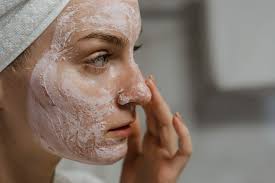
Chemical Exfoliation: The Key to Smooth, Radiant Skin
Chemical exfoliation has grown in popularity over the years, and for good reason.
While it might sound intimidating at first, it’s actually one of the most effective ways to improve skin texture, address blemishes, and revive dull skin.
Unlike physical scrubs that require rubbing, chemical exfoliants work by dissolving dead skin cells and other impurities, giving your skin a healthy, smooth glow.
Let’s break down the science of chemical exfoliation and why it could be your new best friend in skincare.
What is a Chemical Exfoliant?
A chemical exfoliant is an acid-based product designed to exfoliate the skin by breaking down the bonds between dead skin cells.
These exfoliants work without any physical abrasion, meaning you don’t need to scrub your face.
Instead, they dissolve the buildup of dead cells, excess oil, and debris, which helps to clear the skin and improve its appearance.
Because they work chemically rather than physically, many people find them to be gentler and more effective at delivering smoother skin without irritation.
How Do Chemical Exfoliants Work?
Chemical exfoliants, such as AHAs (Alpha Hydroxy Acids) and BHAs (Beta Hydroxy Acids), penetrate the skin and break apart the “glue” that holds dead skin cells together.
Once this bond is broken, the dead cells slough off, revealing fresh, youthful skin underneath.
AHAs (like glycolic, lactic, or malic acids) work primarily on the skin’s surface, helping to brighten the complexion and improve texture. They are especially beneficial for dry or sun-damaged skin.
BHAs (like salicylic acid) go deeper into the pores to clear out excess oil, dirt, and bacteria, making them ideal for oily and acne-prone skin.
While the thought of using acids on your skin might sound intimidating, the concentrations in skincare products are carefully controlled, so you can get all the benefits without the harsh effects. However, finding the right acid for your skin type is key to ensuring you get the best results.
Which Chemical Exfoliants Should You Use?
With so many different acids available, it can be hard to know which one will work best for you. Here’s a rundown of some popular exfoliating acids and their benefits:
Glycolic Acid: Great for normal to oily skin, this AHA helps exfoliate the surface of the skin, improve skin texture, and minimize the appearance of pores.
Malic Acid: A lesser-known AHA, malic acid helps revive dull skin by promoting cell turnover. It’s found in many face masks and serums, giving your skin that radiant glow.
Lactic Acid: Gentle enough for dry and sensitive skin, lactic acid hydrates while exfoliating. It helps remove flaky patches, leaving your skin smooth and nourished.
Salicylic Acid: The go-to BHA for acne-prone skin, salicylic acid works deep in the pores to clear blockages caused by excess oil and bacteria. It’s fantastic for preventing breakouts and minimizing blemishes.
How to Use a Chemical Exfoliant
The method of use depends on the product form, so here’s a basic guide:
Face Wash: Since the acid concentration is lower, face washes can be used twice daily without overwhelming your skin. You’ll notice your skin feeling cleaner and more refreshed with regular use.
Toner: Toners usually contain higher concentrations of acids, so they should be used 2-3 times a week initially. You can increase the frequency depending on how your skin reacts.
Serums: Chemical exfoliant serums can be applied in the evening, but the frequency varies.
Follow the instructions on the product, as some serums may require only 2-3 times a week, while others may be okay for nightly use.
Face Masks: Since masks often contain stronger acids, limit their use to 1-3 times a week. Overuse can irritate your skin.
Can I Use a Face Mask After a Chemical Exfoliant?
It’s best to avoid using a face mask immediately after exfoliating with acids, especially if the mask contains any acids or strong ingredients that might irritate your skin.
If you want to use a mask for hydration or calming, wait about 20 minutes to let your skin restore its balance.
After exfoliation, your skin’s barrier may be a bit more sensitive, so applying a soothing, water-based moisturizer or a hydrating mask can help.
Can I Use Chemical Exfoliants Under the Eyes?
The skin around your eyes is much thinner and more sensitive than the rest of your face. For this reason, it’s generally best to avoid using harsh acids directly around the eye area.
However, gentle acids like glycolic (in lower concentrations) can be used to treat dark circles, but always be cautious and avoid irritation.
For intense hydration around the eyes, consider using hyaluronic acid, which is safe and great for providing moisture without the risk of irritation.
How Quickly Can You See Results?
The results from chemical exfoliation can vary, but many people notice brighter, smoother skin within the first week of use. Regular use can also help reduce blemishes, fine lines, and wrinkles. Here’s what to expect:
Immediate Glow: Some people notice smoother, fresher skin immediately after a chemical exfoliation session.
4 Weeks: After continued use, you may see improvements in skin texture, smaller pores, and reduced signs of aging.
Long-Term Results: Over time, chemical exfoliation can help reduce breakouts and prevent the buildup of dead skin cells, leaving your skin looking youthful and healthy.
The Dos and Don’ts of Using Chemical Exfoliants
The Dos:
Do find the best product suited for your skin type (AHAs for dry skin, BHAs for oily/acne-prone skin).
Do use it as directed to achieve optimal results.
Do consult with a dermatologist if you have any concerns about which acid to choose.
Do apply sunscreen every day, especially when using chemical exfoliants, as your skin will be more sensitive to the sun.
Do use chemical exfoliants to help with blemishes, dullness, and fine lines.
The Don’ts:
Don’t use harsh scrubs or abrasive cloths with chemical exfoliants.
Don’t use them on broken or irritated skin.
Don’t overuse acids, as this can lead to dryness, irritation, and sensitivity.
Don’t apply strong exfoliants near your eyes.
Don’t use multiple acid-based products at once—this could be too much for your skin.
Final Thoughts
Chemical exfoliation is one of the most effective ways to rejuvenate and maintain healthy, glowing skin. Whether you choose AHAs or BHAs, the key is to find the right product for your skin type and use it consistently.
Remember, less is more when it comes to exfoliation. Start slow, patch-test your products, and make sure to use sunscreen to protect your freshly exfoliated skin.
Soon enough, you’ll notice smoother, clearer, and more radiant skin!


